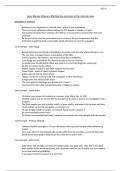AC2.4
Asses the key influence affecting the outcomes of the criminal cases
Reliability of evidence
- Evidence is very important in criminal cases - physical and testimonial
- There has to be sufficient evidence before the CPS decide to charge a suspect
- Prosecution presents their evidence; the defence cross examines and presents their own
evidence.
- By the end of the trial the prosecution has to convince the jury/magistrates that the
defendant is guilty beyond a reasonable doubt otherwise he must be acquitted.
Case Example - Colin Stagg
- Rachel Nickell was murdered in Wimbledon Common, with the only witness being her son
- The son, Alex, managed to give a description of the killer
- Criminal profiler, Paul Britton, was hired to help the investigation
- Colin Stagg was arrested for the murder but there was no evidence
- An undercover female police officer was used to try and trap Stagg into confessing
- He did not confess to the officer
- Robert Napper refused to give DNA evidence to the police
- Green Chain - series of rapes by Robert Napper
- Britton did not link the Green Chain
- Napper murdered a young mum and a daughter in their own home
- A fingerprint was found at the scene
- The case against Colin Stagg was thrown out of court
- Paint found in Alex’s hair patched the paint of Napper’s toolbox
Case Example - David Butler
- Mr Butler was accused of murdering a woman, Anne Marie Foy, in 2005.
- His DNA sample was on record after he had given it to them as part of an investigation into a
burglary.
- The DNA sample was only a partial match, of poor quality, and experts at the time said they
could neither say that he was guilty nor rule him out.
- He spent eight months in prison, on remand, facing murder charges. T
- he case eventually went to trial
- Mr Butler was acquitted and finally released, and nobody was ever charged with the murder.
Case Example - Anthony Diedrick
- Anthony Diedrick strangled a 27-year-old doctor who rejected him after their relationship
ended.
- Four years later he was charged with murder after forensic scientists uncovered three tiny
blood specks belonging to Diedrick on the collar of her pink T-shirt.
Case Example - Sally Clarke
- Sally Clarke was wrongly convicted of murdering her two baby sons. They had in fact died
from sudden infant death syndrome, but a professor told the jury that this was very unlikely
to be true based on probability.
- It was later found his research was incorrect.
, AC2.4
- This demonstrates how evidence that is incorrect can lead to miscarriages of justice.
Case Example - Stephen Downing
- Wendy Sewell was attacked, in Bakewell Cemetery, at lunchtime on 12 September 1973. A
witness, Charles Carman, saw her enter the cemetery at about 12:50 pm. She was beaten
around the head with the handle of a pickaxe and sexually assaulted
- Stephen Downing, who worked at the cemetery, was the person who found the body and
called the police.
- A forensic scientist Norman Lee gave evidence that the blood found on the accused could
only have been present if he had been responsible for the assault.
- This evidence led to him being found guilty
- He remained in prison for 27 years before his conviction was quashed
Witnesses
- Both prosecution and defence teams are entitled to call witnesses to give testimonial
evidence. This is given in person, unless they are vulnerable or intimidated witnesses
- Witnesses can be called by both sides to give evidence - this is called examination- in-chief.
There is also an opportunity to cross examine.
- Jurors and magistrates can give whatever weight they choose to the evidence of witnesses.
The quality of their evidence can determine the outcome of the trial eg. Have they been
shown to lie, is there evidence inconsistent, unreliable or not credible.
- Racial and gender stereotypes held by jurors may influence how likely the jury are to believe
a witness testimony
- In addition to this, Brodsky et al found that juror’s view of the witnesses knowledge and
factors like likeability influenced them in deciding whether to believe their evidence.
Case Example - Ronald Cotton
- In July 1984, a man broke into Jennifer Thompson-Cannino’s apartment and sexually
assaulted her.
- Ronald Cotton was arrested and charged based on the basis of Jennifer choosing Cotton out
of a photo lineup
- On June 30, 1995, Cotton was officially cleared of all charges and released from prison. In
July 1995, the governor of North Carolina officially pardoned Cotton. Cotton had served 10.5
years in prison.





